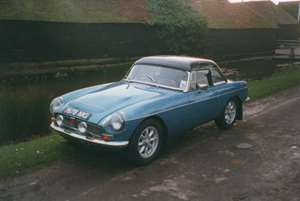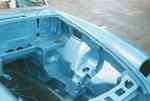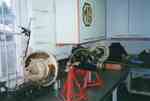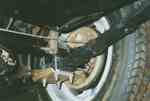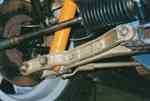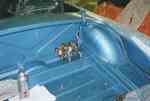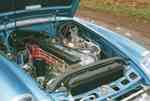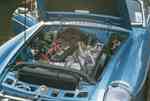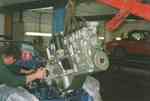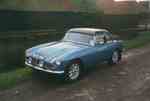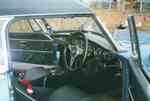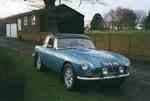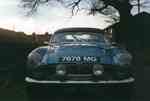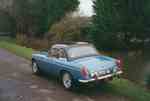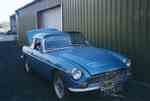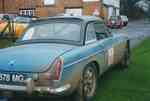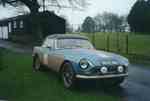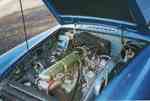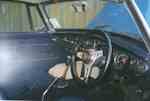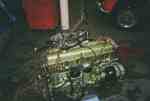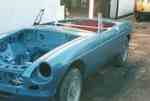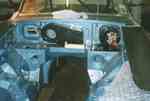Time mellows and forty years after its launch the MGC has developed a cult following. With historic rallying so popular, the MGB has become almost standard equipment for many competitors and now enjoys a more successful competition record that when it was in production and is often seen conquering supposedly superior machinery. Truly the B is a giant killer. Where does this leave the C? In the lay-by while the B takes all the glory? You may think so. But Maidstone Sports Cars were about to redress the balance. We were approached by a customer with an MGC roadster who wanted to use his car for historic rallying. He had entered 'LE JOG' and required that his MG should be brought up to Rally Specification. The MG in question was well known in MGOC circles, as it was Geoff Shirt's old MGC. It was rather tired and tatty and hadn't been used for some time. Our initial inspection highlighted many problems. However we produced a detailed proposal of the specification required for competition and then faxed our estimate to Moscow. Yes, Moscow, the owner Roger Wills, is not a Russian but works and lives in Moscow, so all communication was by fax or phone. Timing was crucial as the specification was only agreed at the end of September and Le Jog' started on December 3rd so considering the amount of work required we were going to have to go some.
The first thing we did was to steam clean the entire vehicle followed by a complete strip down to a bare shell. The engine bay and boot lid had been painted in Hammerite and therefore had to be shot-blasted clean which exposed a great deal of corrosion. The lower rear wings, rear valence and boot floor were also quite rotten. New panels were fitted as required including repair panels to the rear bulkhead to cover speaker holes and to create a fireproof wall.We added new reinforcement brackets and braces to suspension and steering points, as rallying can be a tough process. All new panels were then sealed and the body made ready for painting. This was duly carried out in 'Ice Blue Metallic' using two-pack paint and the result looked good.
While the body was being refurbished in our body-shop, work was progressing on the other components. Suspension, axle, heater box, pedal box were also shot-blasted and all the black components powder coated and others zinc plated. The engine assembly was stripped and checked and only needed a new timing chain, oil seals and gaskets along with a core plug set. The flywheel was lightened and balanced and an uprated clutch fitted. The gearbox was also surprisingly good, only requiring bearings and oil seals. The axle was a different matter and was completely shot needing new crown wheel and pinion, bearing etc. Due to unavailability we used a standard MGB ratio which should certainly help with acceleration. All items were cleaned and painted in the correct colours.
With the body now complete it was time to tackle the suspension. MGC GT rear leaf springs were fitted along with polyurethane bushes. These are a heavy-duty spring and would also raise the vehicle ride height which should help over rough terrain. The front suspension was rebuilt using polyurethane bushes throughout, uprated torsion bars and Koni adjustable shock absorbers. The steering rack was converted to 'quick rack' to help with response. Next the brakes, these remained pretty standard using new discs and reconditioned calipers, EBC Kevlar brake pads and braided brake flexibles. The rear brakes were kept standard. The brake lines renewed and DOT 5 high boiling point fluid was to be used throughout. The fuel system was to use a new standard fuel tank but with twin switchable Facet fuel pumps fitted into the boot and a fuel regulator in the engine bay.
The new fuel lines were run as per the MGB. Carburettors remained the standard twin SUs. The electrical system, probably the most important thing on a rally car, was completely replaced. We fitted a new loom powered by a high output alternator, as there were so many ancillaries to supply. We fitted twin ignition coils and a modified distributor along with Magnecor leads. An auxiliary loom and fuse box were made and fitted as we also installed under bonnet and boot lighting, front spot lights, rear reverse light, rear fog light and interior lighting, all running through relays of course. A pair of halogen headlights with Xenon bulbs supplemented the halogen spotlights and certainly gave a good spread of light. All switches on the dash were marked and the battery cut-off switch was fitted into the rear kick panel. The C's radiator was re-cored with a high efficiency five row core, in fact the biggest available and with the assistance of a Facet electric cooling fan overheating should be a thing of the past. All hoses were replaced as a matter of course.
Safety is always paramount, so a 'Safety Devices' roll cage was installed and secured along with twin four point harnesses. Comfort is another important factor and a decent seat is imperative. A seat which is not only comfortable but one that secures you. As this was a historic rally car, a pair of period rally seats and headrests fitted the bill. Not the easiest to get in and out of, but great once you're seated. A fire extinguisher and a navigator's footrest finished the job. To aid with navigation a Retro 2 Tripmeter was fitted to the dash plus a note reader. Auxiliary power points were fitted into the centre console to run the navigator's 'potty' (a map reading light and magnifier) and auxiliary lights. A horn button was built into the footrest for the navigator to operate. Extra storage was added with a large map pocket fitted into the passenger door and net pockets were strategically placed around the cockpit.
The interior remained fully trimmed with carpets and panels. A 'works' hardtop complemented the look of the vehicle. Along with the engine and gearbox all the auxiliaries could be assembled. A Downtown tubular manifold and exhaust system were installed along with the rebuilt carburettors. The engine should breathe much better with this type of exhaust. All fluids were replenished using good quality oils. A new set of Minilite wheels were chosen and fitted with Yokohama 185/70 x 15 tyres. Not cheap but they gave the car a really purposeful look. The engine start-up was uneventful and with the lightened, flywheel and better advance on the distributor it really wanted to rev. With all the weight back in the car and the suspension settled now was the time to set the torsion bars and shock absorbers. Tracking and camber were also set up, brake and clutch systems bled and tested. Knowing how tough some of these events can be, the next job was to protect the underside, so we fabricated a massive sump under shield out of 0.25 inch aluminium plate. This stretched from the radiator to the back of the gearbox. Mounted on blocks to clear the exhaust and to allow the engine bay heat to disperse, it certainly was a feat of engineering.
Other protection was added to all brake, clutch and wiring lines. Proper rally mud flaps were fitted all around. Front and rear towing eyes were added to meet the regulations. Stick on number plates and headlamp cowls completed the ensemble and the vehicle looked as though it had just escaped from the 1967 RAC Rally. Road testing began and everyone was surprised at just how well the vehicle drove. The ride, handling and steering were super; positive and direct, yet compliant. It was hard to imagine that you had 700lbs of cast iron hanging over the front wheels. The brakes were positive and Kevlar pads gave excellent high speed braking with no fade. The changed axle ratio aided acceleration and with the 'revy' engine she pulled 'like a train'. In fact the whole car felt very unlike an MGC.
With the overdrive switch on the gearlever knob as per the 'works' cars all the controls fell readily to hand. To ensure optimum performance a session on the rolling road was booked and another 20% of power was unleashed; this MGC really has got potential. Our customer was flying in from Moscow to compete in the event and therefore we had to act as "ship's husband" and provide everything required. A full spares package of tool kit, fuel cans, warning triangle, jack, pumps, towrope, pencils and clipboards was assembled. In fact a week before the event he managed to come and see the transformed rally car. I don't think he could believe his eyes, as two months earlier he had left us a very tired and tatty MGC and now he had a near 'concourse' period car. But 'the proof of the pudding' was to be 'in the driving' and he found out that this MGC was no pudding. MGCs are not supposed to go, handle and stop like this and he couldn't wait for the start of LE JOG. A colleague of his was also competing in LE JOG driving an MGB but the C out-handled, had better steering and performed better than the MGB, quite amazing. This should not happen. After the weekend testing our customer flew back to work in Moscow and left us to make the final adjustments and some slight modifications. We added additional brake ducting as it was found that the brakes needed a bit more cooling to help stop the 'beast'. All the spares were packed away in the boot plus many extras. The retro meter trip was re-calibrated. The vehicle was cleaned and fuelled up, awaiting collection.
On the actual rally, the car performed faultlessly and managed to win its class and get Roger the best novice driver. Not bad for a first try! We think it should have also won best presented car because it certainly looked the part, but perhaps we are a little biased. The car lived up to our expectations and probably surprised a lot of people. After doing Land's End to John o'Groats in 36 hours, in the middle of winter the MGC didn't look quite so good on its return but a pressure wash soon brought it back to pristine condition. Damage was limited to a stoved-in undershield and a lost headlamp cowl (somewhere in a Welsh forest apparently) not bad considering what she had gone through. A thorough check over, service and repair would be needed before the next event but this work can be left till later on, now that the pressure is off. So perhaps in 1967 the press were wrong and underneath it all the MGC was a good car just waiting to get out and with a little help from the technicians at Maidstone Sports Cars, its true potential has been unleashed, forty years too late. Perhaps the MGC is the sleeping giant of the historic rally world.
